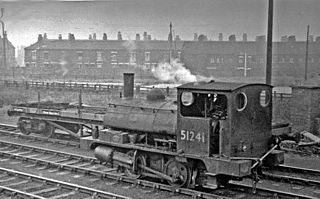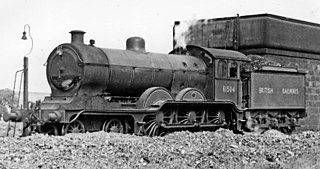
The LNER Class A4 is a class of streamlined 4-6-2 steam locomotive designed by Nigel Gresley for the London and North Eastern Railway in 1935. Their streamlined design gave them high-speed capability as well as making them instantly recognisable, and one of the class, 4468 Mallard, holds the world record as the fastest steam locomotive. Thirty-five of the class were built to haul express passenger trains on the East Coast Main Line route from London Kings Cross via York to Newcastle, and later via Newcastle to Edinburgh, Scotland. They remained in service on the East Coast Main Line until the early 1960s when they were replaced by Deltic diesel locomotives; they themselves proving to be worthy successors to the A4s. Several A4s saw out their remaining days until 1966 in Scotland, particularly on the Aberdeen – Glasgow express trains, for which they were used to improve the timing from 3.5 to 3 hours.

Airfix is a British brand and former manufacturing company which produced injection-moulded plastic scale model kits. In the UK, the name 'Airfix' has become practically synonymous with plastic models of this type, often simply referred to as "an airfix kit" even if made by another manufacturer.

The British Railways Standard Class 9F2-10-0 is a class of steam locomotive designed for British Railways by Robert Riddles. The Class 9F was the last in a series of standardised locomotive classes designed for British Railways during the 1950s, and was intended for use on fast, heavy freight trains over long distances. It was one of the most powerful steam locomotive types ever built for British Railways, and successfully performed its intended duties. The 9F class was given the nickname of 'Spaceship', due to its size and shape.

The Great Western Railway 3700 Class, or City Class, locomotives were a series of twenty 4-4-0 steam locomotives, designed for hauling express passenger trains.
The London and North Eastern Railway (LNER) produced several classes of locomotive, mostly to the designs of Nigel Gresley, characterised by a three-cylinder layout with a parallel boiler and round-topped firebox. It produced the most famous locomotive of its day, 4468 'Mallard', the holder of the world steam locomotive speed record. It also built the world-famous 4472 'Flying Scotsman'. However, its locomotive inheritance was much greater than just the 'A4 Class', it also produced highly successful mixed-traffic and freight designs.

English Electric DP1, commonly known as Deltic, is a prototype 3,300 hp (2,500 kW) demonstrator locomotive employing two Napier Deltic engines, built by English Electric in 1955.

The BR Standard Class 4 2-6-0 is a class of steam locomotive designed by Robert Riddles for British Railways (BR). 115 locomotives were built to this standard.
Dapol Ltd is a model railway manufacturer based in Chirk, Wales. The factory where some of the design and manufacturing take place is just over the border in England. The company is known for its model railway products in N gauge, OO gauge and O gauge.

The London, Midland and Scottish Railway (LMS) Royal Scot Class is a class of 4-6-0 express passenger locomotive introduced in 1927. Originally having parallel boilers, all members were later rebuilt with tapered type 2A boilers, and were in effect two classes.

The London, Midland and Scottish Railway (LMS) Garratt was a class of Garratt 2-6-0+0-6-2 steam locomotive designed for heavy freight. A total of 33 were built from 1927, making them the most numerous class of Garratt in Britain.

The SR V class, more commonly known as the Schools class, is a class of steam locomotive designed by Richard Maunsell for the Southern Railway. The class was a cut down version of his Lord Nelson class but also incorporated components from Urie and Maunsell's LSWR/SR King Arthur class. It was the last locomotive in Britain to be designed with a 4-4-0 wheel arrangement, and was the most powerful class of 4-4-0 ever produced in Europe. All 40 of the class were named after English public schools, and were designed to provide a powerful class of intermediate express passenger locomotive on semi-fast services for lines which could cope with high axle loads but some of which had short turntables.

The Hunslet Austerity 0-6-0ST is a class of steam locomotive designed by Hunslet Engine Company for shunting. The class became the standard British shunting locomotive during the Second World War, and production continued until 1964 at various locomotive manufacturers.

The GWR 6100 Class is a class of 2-6-2T side tank steam locomotives.

The L&YR Class 21 is a class of small 0-4-0ST steam locomotive built by the Lancashire and Yorkshire Railway for shunting duties. They were nicknamed Pugs.

The Great Eastern Railway (GER) Class S69, also known as 1500 Class, and later classified B12 by the London and North Eastern Railway (LNER) is a class of 4-6-0 steam locomotive designed to haul express passenger trains from London Liverpool Street station along the Great Eastern Main Line. Originally they were designed by S. D. Holden, but were much rebuilt, resulting in several subclasses.

The LNER Class A1/1 consisted of a single 4-6-2 "Pacific" express passenger locomotive rebuilt in 1945 from an A1 class locomotive, by Edward Thompson. It was intended as the prototype of a new design of pacific locomotives improving the A4 design of Thompson's predecessor Sir Nigel Gresley. No further examples were built due to Thompson's retirement in 1946.

Rosebud Kitmaster is the brand name of a short-lived but critically acclaimed range of plastic assembly kits, manufactured in the United Kingdom by Rosebud Dolls Ltd of Raunds, Northamptonshire. Introduced from May 1959, the range rapidly expanded to include 34 models of railway locomotives and coaches in OO, HO and TT scales, and eventually, one motorcycle in 1:16 scale.

The London and North Eastern Railway (LNER) Class A2/3 was a class of 4-6-2 steam locomotives. They were newly constructed locomotives, fulfilling the requirement identified by Edward Thompson for a standard express passenger locomotive of the 4-6-2 arrangement with 6 ft 2 in (1.880 m) driving wheels. Fifteen engines were constructed according to this original design, but following the retirement of Thompson as CME, the remaining fifteen locomotives that were planned were immediately redesigned and ultimately emerged as Peppercorn Class A2.

The London and North Eastern Railway Class A2/2 was a class of six 4-6-2 steam locomotives rebuilt by Edward Thompson in 1943 and 1944 from his predecessor's P2 Class of 2-8-2 express passenger locomotives. The rebuilds were not particularly successful and all were withdrawn and scrapped between 1959 and 1961.

The British Railways (BR) ex-WD Austerity 2-8-0 was a class of 733 2-8-0 steam locomotives designed for heavy freight. These locomotives of the WD Austerity 2-8-0 type had been constructed by the War Department, as war locomotives 1943–1945. After the war, they were surplus and so in 1946 the LNER bought 200 of them, classifying them as LNER Class O7, and by the end of 1947 when the LNER was nationalised, had taken another 278 O7s on loan. After nationalisation, BR purchased 533 more 2-8-0s, including all of those on loan, giving a class total of 733. As many of these needed overhauling before being put to work, they were activated slowly. BR chose to reclassified from LNER Class O7 and renumbered them from the 6xxxx LNER series in the 90000–732 series for BR standard designs.


















